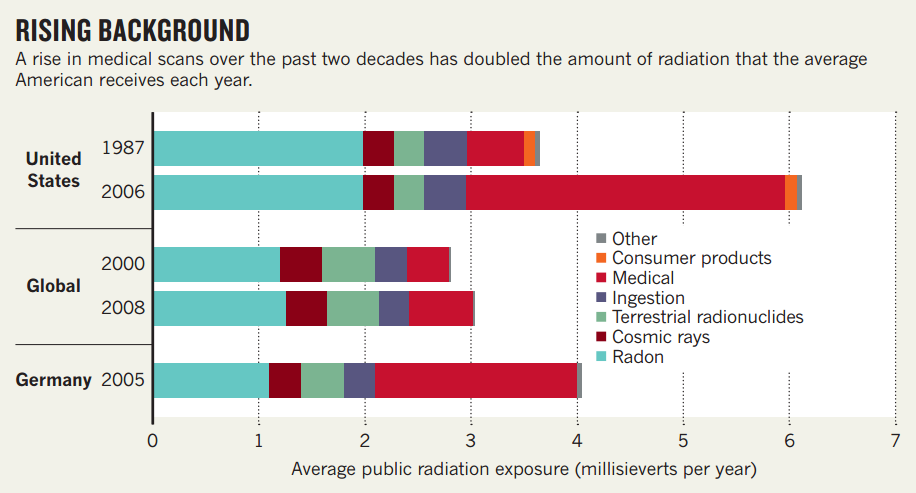Low Level Radioactivity

Concerns of General Public
Health risk from exposure to radiations is one of the major concerns of the general public related to nuclear power generation. These concerns are related to emissions from normal operation, from waste disposal and from accidents. This page aims to address these concerns. Some of the information presented here comes from the website: radioactivity.eu.com where further details can be found.
Sources of radioactivity received by humans
At the present time the biggest single contribution to radioactivity received by people is from medical procedures. As shown in the pie chart, the dose received from all nuclear operations is tiny in comparison. Radioactivity from naturally occurring isotopes make up about 50% of the received dose but these is very dependent on local geology. Cosmic radiation makes up about 10%.

Sources of exposure to radiation measured in units of milli-sieverts (mSv)
The graph below illustrates the expansion of radiation doses received from medicine.

It is paradoxical that nuclear power releases less radiation into the environment than any other major energy source. The worst offender is coal, a mineral of the earth’s crust that contains a substantial volume of the radioactive elements uranium and thorium. Burning coal gasifies its organic materials, concentrating its mineral components into the remaining waste, called fly ash. So much coal is burned in the world and so much fly ash produced that coal is actually the major source of radioactive releases into the environment.
Natural Sources of Radioactivity: Radioisotopes
 | Different elements have different numbers of protons in the nucleus. The relative number of neutrons to protons in the nucleus decide the stability of the element. All elements have unstable forms, "radioisotopes" which are unstable with lifetimes dependent on the distance from the stability region indicated in the plot. When the elements were produced in the early universe many isotopes were produced but by now, only the stable or nearly stable remain in the natural environment. Two elements have unstable primordial isotopes with long lifetimes which have significant contributions to natural radioactivity doses, these are uranium and potassium. |
Natural Sources of Radioactivity: Cosmic Radiation

The Earth is constantly bombarded by radiation arriving from outer space. Much of this radiation is emitted by the sun but some arrives from distant sources such as supernova explosions. The total energy from cosmic rays arriving at the Earth is roughly equal to the total energy arriving from star light.
This radiation has both a direct effect on DNA in the body and also creates more radioisotopes, as an example carbon 14 used for carbon dating of ancient objects.
The Earth is protected from charge cosmic rays by the magnetic field and the atmosphere of the earth absorbs much of this radiation. Cities at higher altitude receive more cosmic radiation and flights in aircraft give significant doses. The figure below gives typical doses received on flights. It can be seen that frequently flyers and aircrew receive well over the received doses of people staying at sea level.

Residual artificial radioactivity in the environment
A study of radioactivity in wine from the Bordeaux region in France has been performed where the amount of the radioisotope 137Cs was measured using its distinctive gamma decay line. On the plot below the increase in activity due to Chernobyl can be seen to be tiny compared to the activity of the atmospheric nuclear weapons test between 1950 and 1975. These results can be taken as a marker of contamination in agriculture in Europe in general and shows the rapid decay of the contamination from this isotope which causes cancer.

Studies of health risks of low-level radiation
Because the additional received radiation does from nuclear power generation is so low it is extremely difficult to arrive at conclusive results of the effects on health.
A study of more than 300,000 nuclear industry workers in France, the United States and the United Kingdom, all of whom wore dosimeter badges to measure their received radiation dose was reported in Nature in 2015. The workers received on average just 1.1 mSv per year above background radiation, which itself is about 2–3 mSv per year from sources such as cosmic rays and radon. The study confirmed that the risk of leukaemia does rise proportionately with higher doses. Researchers found that 531 of the workers died from leukaemia during the average 27 years they spent in the industry; the data suggest that 30 of those deaths could be attributed to the radiation. Even in this large study, there was no direct evidence that workers who had accumulated extremely low doses of radiation (below a total of 50 mSv) had an increased risk of leukaemia.
Video on health effects of Fukushima and Chernobyl
From: World Nuclear Association